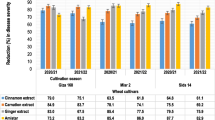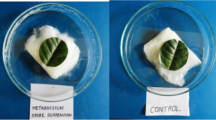Abstract
An experiment was conducted to study the effectiveness of contact, systemic and botanical fungicides, and indigenous biocontrol agents in controlling red root rot disease of tea plants. In general, all tested bioagents, the combination of Pseudomonas fluorescens and Trichoderma atroviride reduced red root disease incidence recorded in two consecutive field experiments. Among the fourteen treatments tested, soil drenching of systemic fungicides was superior but similar to the combination between P. fluorescens and T. atroviride. In contrast, the maximum green leaf yield and plant growth was achieved when soil application of biocontrol agents was carried out. However, the performance of these biocontrol agents under various combinations was on par with systemic fungicides, but superior to botanical fungicides. Correspondingly, the physiological and biochemical parameters were also greatly increased in plants in several treatments when compared to untreated control. The disease increased from 31.5 % to 40.0 % in untreated control plots and those plants were unhealthy in terms of leaf yellowing, stunted growth with heavy flowering, drying of branches and sudden death of bushes. The tea quality parameters were significantly improved in treated plants including total liquor colour, thearubigins, theaflavins, highly polymerized substance and caffeine contents.

Similar content being viewed by others
References
Ajay, D., Tensingh Baliah, N., Baby, U. I., & Premkumar, R. (2004). Impact of soil organic matter on the establishment of bioinoculants. UPASI Tea Research Newsletter, 15, 4–5.
Anita, S., Ponmurugan, P., & Ganesh Babu, R. (2012). Significance of secondary metabolites and enzymes secreted by Trichoderma atroviride isolates for the biological control of Phomopsis canker disease. African Journal of Biotechnology, 11(45), 10350–10357.
AOAC (1990). Estimation of various biochemical parameters. (In K. Helrich (ed), Official Methods of Analysis of the Association of Official Analytical Chemist, 15th edition, (pp.1552–155) Gaithersburg).
Baby, U. I. (2001). Diseases of tea and their management – A review. In P. C. Trivedi (Ed.), Plant Pathology (pp. 315–327). Jaipur: Pointer Publication.
Baby, U. I., & Chandramouli, B. (1996). Biological antagonism of Trichoderma and Gliocladium spp. against certain primary root pathogens of tea. Journal of Plantation Crops, 24, 249–255.
Baby, U. I., & Muraleedharan, N. (2005). Tea diseases, ecology and control. Encylopedia of Pest Management. doi:10.1081/E-EPM-120041219.
Baby, U. I., Ravichandran, R., Ganesan, V., Parthiban, R., & Sukumar, S. (1998). Effect of blister blight disease on the biochemical and quality constituents of green leaf and CTC teas. Tropical Agriculture, 75, 452–456.
Balasubramanian, S., Netto, L. A., & Parathiraj, S. (2010). Unique graft combination of tea, Cr-6017/UPASI-9. Current Science, 98, 1508–1517.
Borthakur, B.K. Dutta, P.K. (1992). Prospects of biocontrol of tea diseases in North East India. (In B.K. Borthakur, Dutta, P.K., (Eds), Proceedings of the 31st Tea Conference, (pp. 163–168). Assam, India.)
Chandramouli, M.R., Baby, U.I. (2002). Control of thorny stem blight disease of tea with fungicides and biocontrol agents. (In P. Rethinum, H.H. Khan, V.M. Reddy, K.P. Mandal, K. Suresh (Eds.), Proceedings of Plantation Crops and Development in the New Millennium, Coconut Development Board, (pp. 531–534). Kochi, India.)
Chen, Z. M., & Chen, X. (1990). The diagnosis of tea diseases and their control. Shanghai: Shanghai Scientific and Technical Publishers, IRTTCS, China.
Cready, M. C., Guggolz, R. M., Silviera, V., & Owens, H. S. (1950). Determination of starch and amylase in vegetables. Analytical Chemistry, 22, 1156.
Dev Choudhury, M. N., & Goswami, M. R. (1983). A rapid method for determination of total polyphenolic matter in tea (Camellia sinesis L.) O Kuntze. Two and a Bud, 30, 59–61.
Dubois, M., Gills, K. A., Hamilton, J. K., Rebers, P. A., & Smith, F. (1956). Sugar estimation by phenol-sulphuric acid method. Analytical Chemistry, 26, 350.
Elad, Y., & Chet, I. (1983). Improved selective medium for isolation of Trichoderma or Fusarium spp. Phytoparasitica, 11, 55–58.
Fravel, D. R. (2005). Commercialization and implementation of biocontrol. Annual Reviews of Phytopathology, 43, 337–359.
Gerhardson, P. (2002). Biological substitutes for pesticides. Trends in Biotechnology, 20, 338–343.
Gnanamangai, B. M., & Ponmurugan, P. (2012). Evaluation of various fungicides and microbial based biocontrol agents against bird’s eye spot disease of tea plants. Crop Protection, 32, 111–118.
Gomez, K.A. Gomez, A.A. (1984). Statistical Procedure for Agricultural Research. Second edition. International Rice Research Institute, (p.183) Los Banos, The Phillippines.
Govindappa, M., Lokesh, S., Ravishankar Rai, V., Rudra Naik, V., & Raju, S. G. (2010). Induction of systemic resistance and management of safflower Macrophomina phaseolina root-rot disease by biocontrol agents. Archives of Phytopathology and Plant Protection, 43(1), 26–40.
Hazarika, M., Mahanta, P. K., & Takeo, T. (1984). Studies on some volatile flavor constituents in orthodox black teas of various clones and flushes in north-east India. Journal of the Science of Food and Agriculture, 35, 1201–1207.
Hudson, J. B., Durairaj, J., Muraleedharan, N., & Dhanakumar, V. G. (1998). Guidelines on tea culture in south India (p. 212). Coonoor: Pioneer Press.
Kalim, S., Luthra, K. P., & Gandhi, S. K. (2000). Influence of bavistin seed treatment on morphological and biochemical parameters of cow pea roots susceptible to Rhizoctonia species. Journal of Mycology and Plant Pathology, 30, 375–379.
King, E. O., Ward, M. K., & Raney, D. E. (1954). Two simple media for the demonstration of Pyocianin and fluorescein. The Journal of Laboratory and Clinical Medicine, 44, 301–307.
Kuster, E., & Williams, S. T. (1964). Selection of media for isolation of Streptomyces. Nature, 202, 928–929.
Lowry, O. H., Rosebrough, N. J., Farr, L., & Randall, R. J. (1951). Protein measurement with the folin phenol reagent. Journal of Biology and Chemistry, 193, 265–275.
Manivel, L., & Hussain, S. (1982). Photosynthesis in tea II, direction of movement of photosynthates. Two Bud, 29, 49–52.
Mendgen, K., Schiewe, A., & Falponi, C. (1992). Biological control of plant diseases. Biology of Crop Protection, 45, 5–20.
Moore, S., & Stein, W. H. (1948). Photometric method for use in the chromatography of amino acids. Journal of Biology and Chemistry, 176, 367–388.
Muraleedharan, N., & Chen, Z. M. (1997). Pests and diseases of tea and their management. Journal of Plantation Crops, 25, 15–43.
Ponmurugan, P., & Baby, U. I. (2007). Evaluation of fungicides and biocontrol agents against Phomopsis canker of tea under field condition. Australasian Journal of Plant Pathology, 36, 68–72.
Ponmurugan, P., Saravanan, D., & Ramya, M. (2010). Culture and biochemical analysis of a tea algal pathogen, Cephaleuros parasiticus. Journal of Phycology, 46, 1017–1023.
Rajkumar, R., Manivel, L., & Marimuthu, S. (1998). Longevity and factors influencing photosynthesis in tea leaves. Photosynthetica, 35, 41–46.
Ramaswamy, S. (1986). Improving tea quality in South India. UPASI Tea Science Department Bull, 41, 12–24.
Sadasivam, S., & Manickam, A. (1996). Biochemical methods (2nd ed., p. 251). New Delhi: New age international Publishers.
Sanjay, R., Ponmurugan, P., & Baby, U. I. (2008). Evaluation of fungicides and biocontrol agents against grey blight disease of tea in the field. Crop Protection, 27, 689–694.
Saravanakumar, D., Vijayakumar, C., Kumar, N., & Samiappan, R. (2007). PGPR- induced defense responses in tea plant against blister blight disease. Crop Protection, 26, 556–565.
Sharma, V.S. and Sathyanarayana, N. (1990). Productivity index of tea (Camellia L. sp.). Proceedings of National Symposium of New Trends in Tea. Crop Improvement of Perennial Species, (NSTT’90), Rubber Research Institute of India, (pp. 16–16), Kottayam, Kerala, India.
Swain, T., & Hillis, W. E. (1959). The phenolic constituents of Prunus domestica I. The quantitative analysis of phenolic constituents. Journal of the Science of Food and Agriculture, 10, 63–68.
Takeo, T., & Oosawa, K. (1976). Photometric analysis and statistical evaluation of black tea infusion. Bulletin National Research Institute of Tea (Japan), 12, 125–181.
Thanaraj, S. N. S., & Seshadri, R. (1990). Influence of polyphenol oxidase activity and polyphenol content of tea shoots on quality of black tea. Journal of the Science of Food and Agriculture, 51, 57–69.
Welburn, A. R. (1994). The spectral determination of chlorophyll a and b, as well as total carotenoids, using various solvents with spectrometers of different resolution. Journal of Plant Physiology, 144, 307–313.
Ziedan, E. H. (2000). Soil treatment with biofertilizers for controlling peanut root and pod rot diseases in Nobaria province. Egypt Journal of Phytopathology, 28(1–2), 17–26.
Acknowledgments
The authors are thankful to the Chairman and Principal of K.S. Rangasamy College of Technology, Tiruchengode, Tamil Nadu, India for providing necessary facilities and constant encouragement to carry out this study. Dr. P. Mohan kumar, Director, UPASI Tea Research Institute, Valparai is gratefully acknowledged for their excellent support in conducting field trails. Moreover the first author is grateful to Jawaharlal Nehru Memorial Fund, New Delhi for awarding Jawaharlal Nehru Doctoral Fellowship.
Author information
Authors and Affiliations
Corresponding author
Rights and permissions
About this article
Cite this article
Manjukarunambika, K., Ponmurugan, P. & Marimuthu, S. Efficacy of various fungicides and indigenous biocontrol agents against red root rot disease of tea plants. Eur J Plant Pathol 137, 67–78 (2013). https://doi.org/10.1007/s10658-013-0217-4
Accepted:
Published:
Issue Date:
DOI: https://doi.org/10.1007/s10658-013-0217-4




